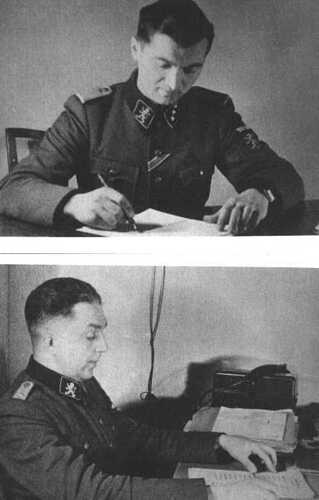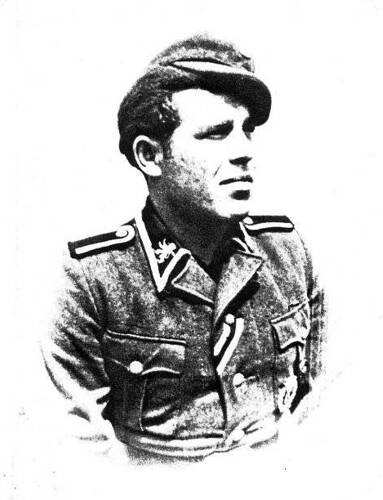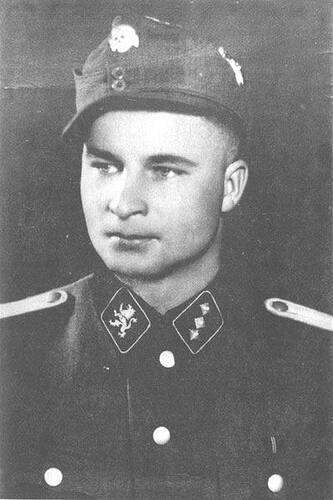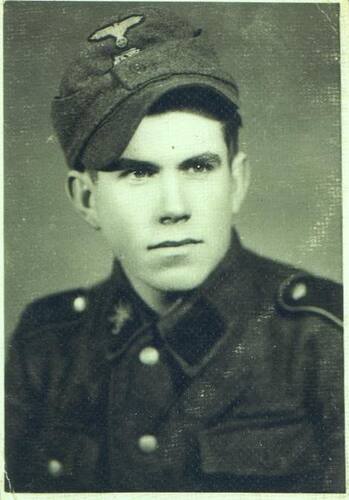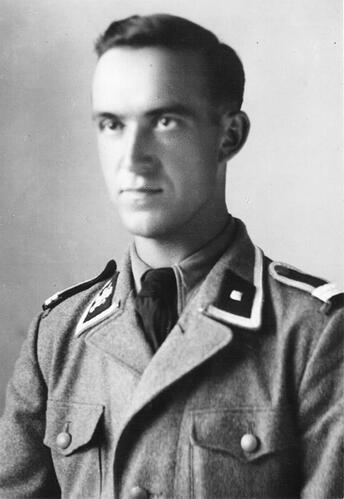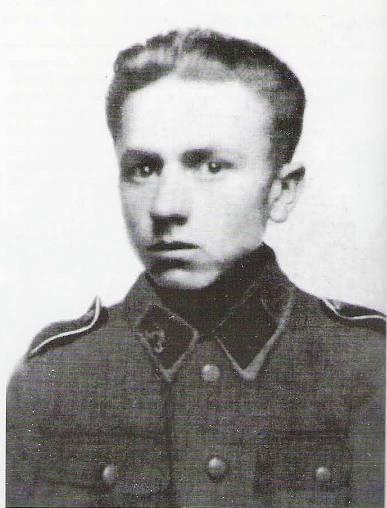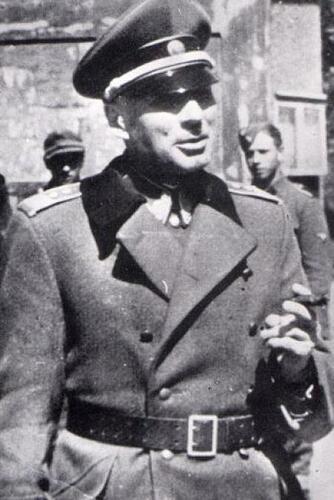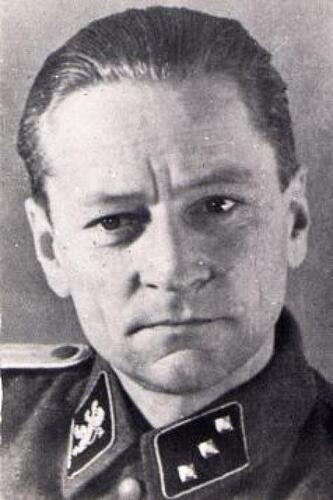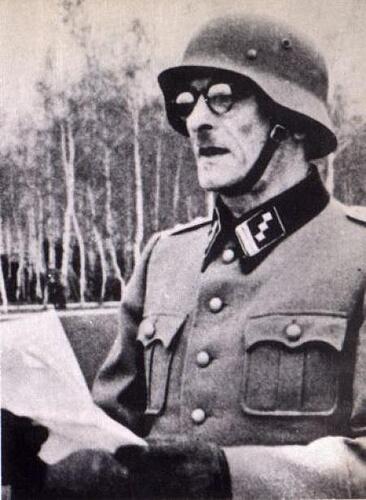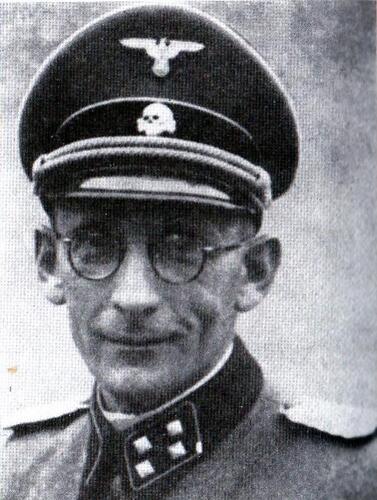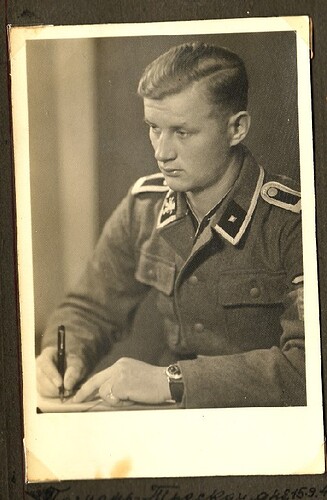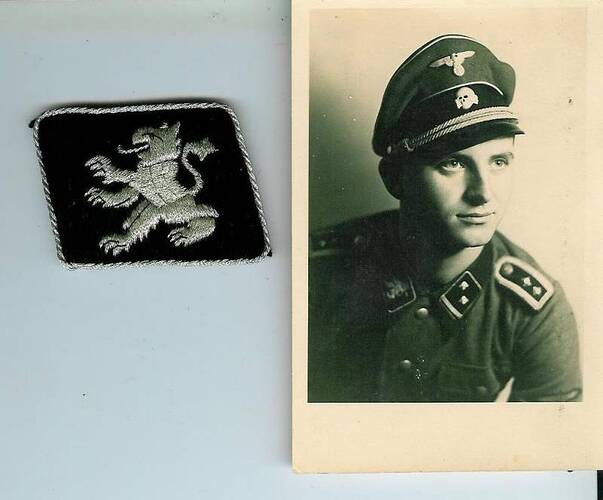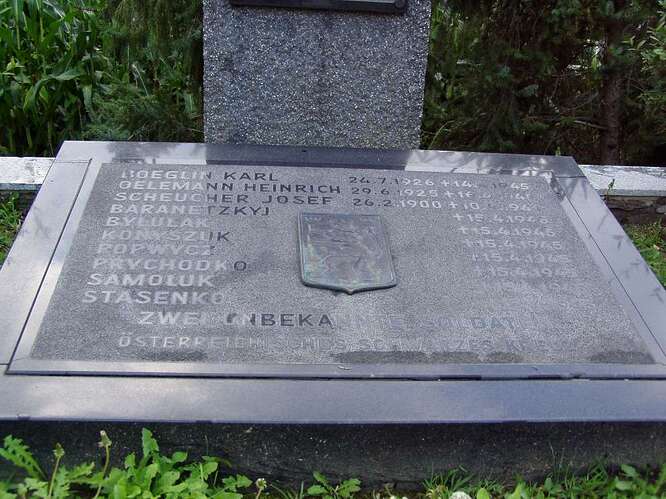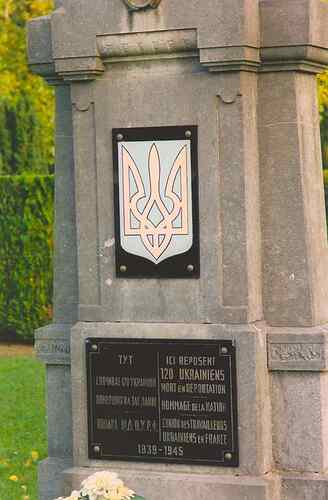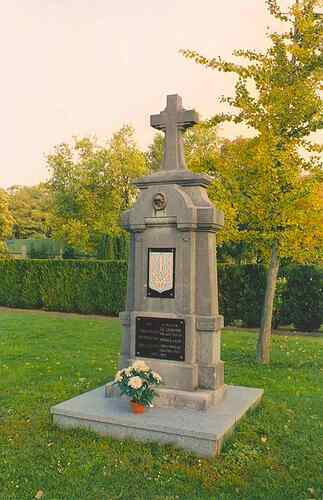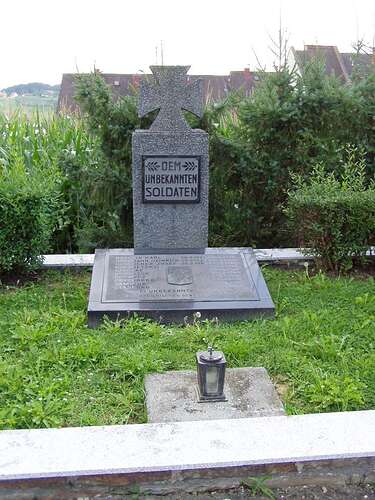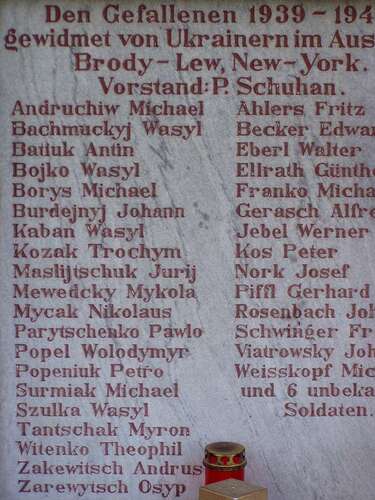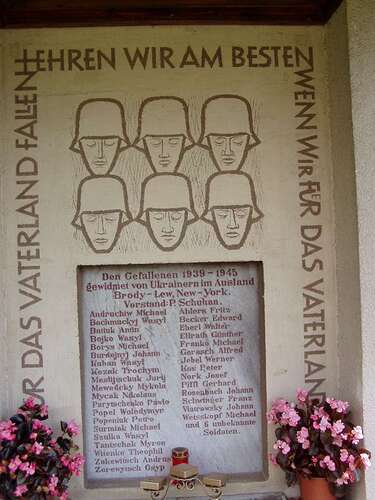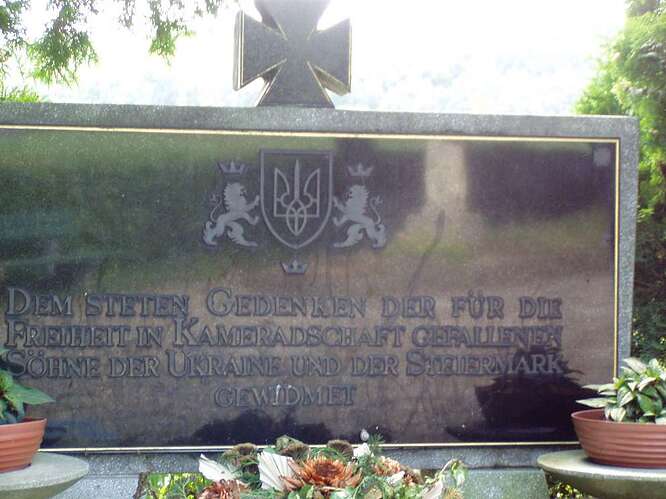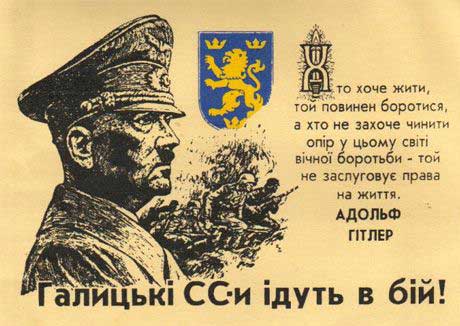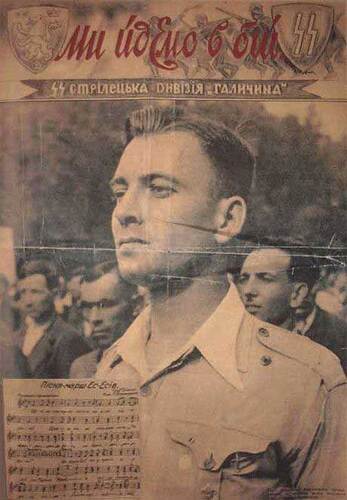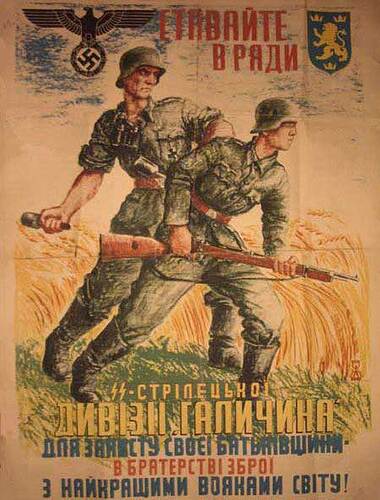Some photos volunteers in SS ‘‘Galizien’’,all of them are volunteers from Western part of Ukraine.From Lviv,Ivano-Frankivsk and Ternopil (it is my city).
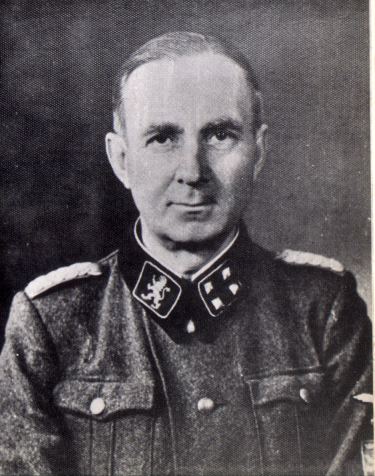
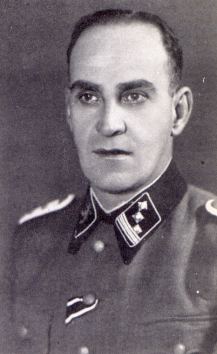
Officers of Division:
1.General Pavlo Shandruk
2.Untersturmführer SS Yuri Krochmaluk
3.Hauptsturmführer SS Dmytro Paliev
4.Sturmbannführer SS Nikolai Palienko
5.Hauptsturmführer SS P.Silenko
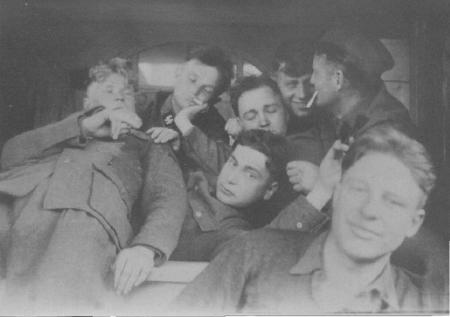
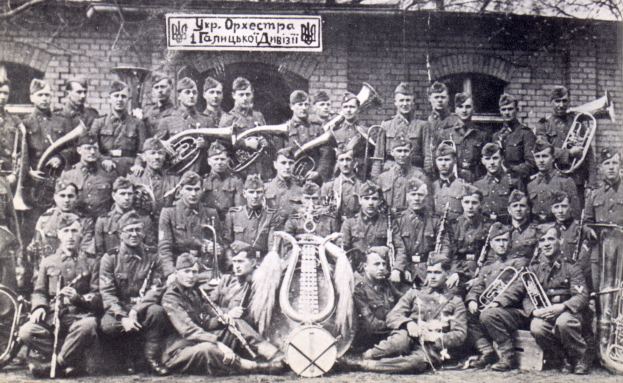


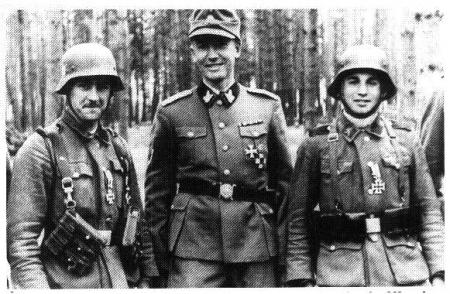
1.Unknown soldiers
2.Division Orchestra
3.Graduates of the artillery courses in Beneshevo (Czech)
4.Unknown soldiers
5.Unknown soldiers
Division Attributes:
Flags of Division:

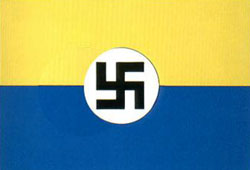
1.Earlier version (1943)
2.Latter version (1944-45)
Medals of Division:
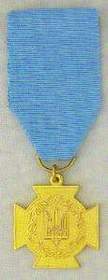
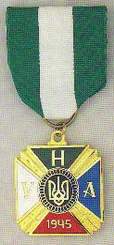
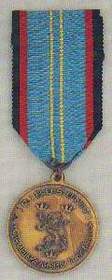
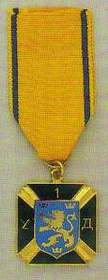

1.Special Merit Cross, awarded to members of UNA.
2.Anniversary medal for all members of UNA.
3.20th anniversary of Galicia Division (1963).
4.Medal issued after division joined UNA.
5.Medal ‘‘Battle of Brody’’.
Uniform Division soldiers:

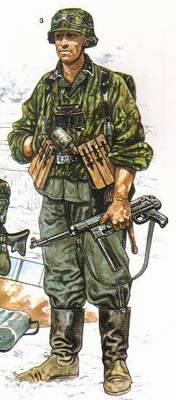

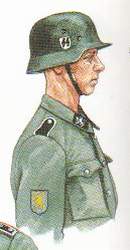
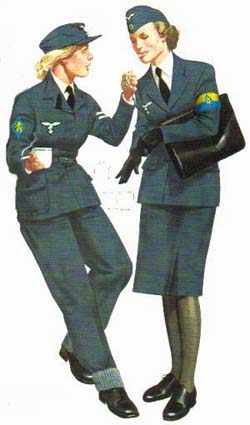
i see General Pavlo didnt have Eagle on his cap.
and i see an SS pilot(?)
very interesting pictures. Better if it has some stories 
Galizien is the bunch that was moved to the UK after the war, it was thought they could prove ‘useful’ against the Russians.
I thought some historical context would be useful here.
From “Murderous Elite: The Waffen-SS and Its Record of Atrocities” by James Pontolillo, p. 51-54.
"[…]14. Waffen-Grenadier-Division der SS (ukrainische Nr. 1) Crimes in Poland
At the outset it should be noted that several of the units used to form the 14. Waffen-Grenadier-Division der SS (ukrainische Nr. 1) – Polizei-Bataillon 201, 31st SD Punitive Detachment, and the Ukrainische Schützmannschaft Bataillon 204 – had a long prior history of participation in extermination operations. Operating in the rear-areas of Poland and the Ukraine, these units collectively murdered thousands of innocent civilians at Lvov, Tarnopol, Lutsk, Kremianets, Voldymyr, Odessa, Izmail, Mikolaiv, Brailov, Vinnitsia, Luminets, Pidhaitsi, and Ustalych.
Soon after the division’s recruiting and formation had begun in late April 1943, unidentified elements took part in several anti-partisan operations in Poland which resulted in the wholesale murder of innocent civilians. Its commander at the time was SS-Brigadeführer Walter Schimana. Röhr et al. (1989) reported the following atrocities specifically attributed to the division:
Date Location District Victims
6/24/43 Majdan Nowy (Zamosc area) 28
7/1/43 Kaszow Krakow 26
7/3/43 Majdan Stary (Zamosc area) 65
8/15/43 Zagaje (S of Kielce) 68
Later that year, divisional elements assisted in the deportation of Polish Jews to KL Auschwitz for extermination. On 20 November 1943, SS-Brigadeführer Fritz Freitag took over as divisional commander and would remain so until his suicide (4/27/45).
By early February 1944, the division had completed most of its general training but was still not ready for action. Nonetheless, HSSPf General Government SS-Obergruppenführer Wilhelm Koppe ordered the partial mobilization of the division to assist with rear-area security duties in southeastern Poland following the Soviet siege of Tarnopol and the resecue of German units entrapped in the Kamenets-Podolsk pocket. The resulting unit, SS-Kampfgruppe Beyersdorff under the command of SS-Obersturmbannführer Friedrich Beyersdorff, was composed of Waffen-Grenadier-Regiment der SS 29, Waffen-Grenadier-Regiment der SS 30 and miscellaneous anti-tank, artillery and engineer support elements. Under the guise of anti-partisan operations this kampfgruppe destroyed 20 villages in Poland, killed in excess of 5,000 innocent civilians, and shipped another 20,000 civilians off to Germany as slave laborers. Röhr et al. (1989) has summarized a number of these atrocities:
Date Location District Victims
2/1-2/44 Borow Lublin ~ 300
" Goscieradow " 143
" Szczecyn (SW of Lublin) ~ 200
" Wolka Szczecka (E of Kielce) ~200
" Zaklikow (S of Lublin) 217
3/27/44 Gozdow Lublin 30
4/1/44 Obrowiec (Zamosc area) 34
The following crimes of SS-Kampfgruppe Beyersdorff are summarized from more substantial accounts in Korman (1990).
Chodaczkow Wielki
On 16 April 1944 elements of SS-Kampfgruppe Beyersdorff entered the town of Chodaczkow Wielki (Tarnopol area) with the apparent intention of exterminating the entire populace. They systematically moved street by street, firing buildings and shooting all civilians they came across. Several small children were caught by SS troopers and hurled into burning buildings to perish in the flames. The conflagration and smoke inevitably drew the attention of the unit’s German command staff which dispatched a motorcycle messenger ordering the men to cease their depredations. By the time the Ukrainian SS troopers had been reined in, 862 innocent civilians lay dead amidst the town’s smoking rubble.
Huta Pieniacka
At the beginning of February 1944 units of the Polish resistance, as well as 400 Soviet partisan cavalrymen under General M. Naumov, established themselves in the area of Huta Pieniacka near Brody with the dual purpose of disrupting German forces and protecting the local inhabitants. The previous months had seen local Ukrainian nationalist militia forcibly evacuate villagers from Huta Brodzka, Huta Nowa, Litowosko, Hucisko Litowiskie, Hucisko Pieniackie and Gleboka Bobutycha concentrating them at Huta Pieniacka presumably for no good purpose. The town’s population had swelled to approximately 1,300 individuals as a result of these transfers. Following this influx of resistance forces, several skirmishes occurred with reinforced patrols from SS-Kampfgruppe Beyersdorff. Outnumbered by German security forces, the partisans withdrew from the area.
On 27 February, German military authorities received erroneous intelligence from Ukrainian sources that arms and ammunition were secretly cached at Huta Pieniacka. A search and secure action was initially authorized, but this was quickly transformed into a “cleansing” action in order to teach the Polish population a lesson. The next morning elements of SS-Kampfgruppe Beyersdorff surrounded the village and attacked in unison on seeing the launch of signal flares. Resistance was practically non-existent: only a few scattered defensive shots were heard initially. Waves of Ukrainian SS-troopers, followed by Ukrainian nationalist militia, swept through the town. Buildings were carefully searched and their occupants driven at gunpoint toward the town’s centrally-located Roman Catholic church. Many civilians were randomly executed along the way and left lying by the side of the road. Buildings were looted of valuables and livestock before being grenaded or fired. Some SS men remained behind lying in wait for anyone hiding in the burning buildings. When desperate civilians emerged, they were mercilessly gunned down. The whole town was soon a confused mass of burning buildings, screaming women, crying children, and the ever-present staccatto of gunfire. Breathing became more and more difficult as the air filled with smoke and the reek of burning bodies.
At the town center, the women and children were separated out and driven into the church where they were shot to death by their captors. SS troopers then looted and desecrated the church. Meanwhile, the men outside in the town square met a similar fate before the guns of the SS. An unlucky few were horribly tortured before they were executed. With the town destroyed and its inhabitants dead, the men of SS-Kampfgruppe Beyersdorff passed liquor around and, raucously singing, performed a victory march out of town. When the fires died down the next morning, all that remained of Huta Pieniacka was a mass of smoking rubble with an occasional chimney sticking up. More than 1,000 of its residents had been murdered. A lucky few had escaped into the surrounding countryside putting as much distance between themselves and the Ukrainian SS as possible. Today all that exists of Huta Pieniacka is a small memorial and sign that mark the town’s former location.
Apologists for the Ukrainian Waffen-SS, such as Logusz (1997), have simultaneously discredited and rationalized the massacre at Huta Pieniacka. In their view, the atrocity probably never occured and is simply Polish Communist propaganda. If the massacre actually occurred, however, then it was undoubtedly justified since (according to Ukrainian sources) Huta Pieniacka was a Communist guerilla stronghold that employed women and children in the manufacture of munitions. Revisionists would have us believe that the inhabitants of Huta Pieniacka were legitimate military targets […]."
Some more info in my next post.
And here the rest:
"[…] Mlynow
On an unspecified date elements of SS-Kampfgruppe Beyersdorff executed upwards of 1,000 innocent civilians from this town and it neighboring villages (Luck area).
Palikrowy
On 12 March 1944 company-strength elements of SS-Kampfgruppe Beyersdorff, with the assistance of Ukrainian nationalist militia, swept through this town in the Tarnopol area murdering approximately 300 defenceless civilians. After plundering Palikrowy, they fired numerous buildings and then returned to Podkamien where cleansing operations were ongoing. Along the way, they murdered 20 civilians at Maliniskach and another 16 civilians at Czernicy.
Podkamien
In late February 1944, elements of SS-Kampfgruppe Beyersdorff entered the town of Podkamien near Brody and conducted a search for hidden weapon and ammunition caches. They found nothing. In the ensuing weeks the town was searched several more times by Ukrainian nationalist militiamen who only found two old, rusty carbines for all their effort. The atmosphere was tense and many residents felt that the Ukrainians were looking for the slightest pretext to justify repressive actions. Some took these security measures as a warning, fleeing to Podhorce and other nearby areas. Many other residents took refuge in a Dominican monastery outside of town.
On 10 March 1944 elements of SS-Kampfgruppe Beyersdorff returned to Podkamien accompanied by Ukrainian nationalist leaders and militiamen. The following day the Ukrainian militia surrounded the Dominican monastery and demanded entrance so that they could perform security checks. They were rebuffed by the monks. Throughout the day the militiamen alternately tried to persuade and then threaten the monks to allow their entrance into the monastery grounds. All their efforts were fruitless.
On the morning of 12 March, Waffen-SS trooopers and Ukrainian militia carefully surrounded the monastery. Any civilians travelling to or from the monastery that day were waylaid, taken aside and executed. At the monastery itself, handgrenades were tossed into the grounds. Those careless enough to show themselves at the monastery’s windows and doorways were fired upon and killed. From within the monastery a handful of local forest rangers retaliated with brisk rifle fire and a few handgrenades that killed and wounded several of the attackers. The remaining Waffen-SS and militia took cover, calling off their abortive attempt to force the monastery gate. Inside the monastery, however, the situation was dire. The forest rangers had used up their scanty supply of ammunition and the only other available weapons were a handful of sickles. The monastery’s abbot, Father Josef Burda, readied everyone for death with the sacraments of Confession and Holy Communion. Unexpectedly, the attackers temporarily withdrew leaving sentries behind (left to conduct the massacre at nearby Palkrowy, see above). By 1:00 pm, however, the Waffen-SS and militia had returned to continue their siege of the monastery.
The German commander resumed the siege by sending an ultimatum to those inside the monastery summoning them to surrender immediately. If they did not, heavy artillery would open fire on the monastery building and its grounds. Some civilians complied with the order, exited the monastery and fled toward the nearby town of Budki hoping to find refuge there. Along the way, however, they were intercepted by Ukrainian nationalist militia and gunned down. A handful of those in the monastery made it into sewers that ran beneath the monastery grounds and past Podkamien. In this manner they were able to pass out of the immediate danger zone and flee to safety. The majority of the people, however, remained inside the monastery. When the time for compliance had run out, the Waffen-SS and militiamen forced their way into the monastery killing everyone in sight. The resulting massacre was bestial in nature as civilians were not merely shot: many were killed or mutilated with blows from sickles, pitchforks and shears. Some individuals were even chased up into the chorus balcony and then thrown down to their deaths on the chapel floor below. When it was all over some 300 dead lay scattered about the monastery grounds.
While this bloody assault on the monastery was taking place, events in Podkamien itself were unfolding in a similar manner. Waffen-SS troopers assisted by Ukrainian Police units conducted a careful building by building sweep through the town. When an individual was stopped, he had to present his identity card. All residents of Polish nationality were taken aside and immediately executed. Inhabitants of Ukrainian origin were left unmolested and allowed to remain in their homes.
By the early morning hours of 13 March, the killing had for the most part ceased. Later that morning the serious organized looting of Podkamien and its monastery began. The SS-troopers and Ukrainian militiamen were assisted in their task by 200 teamsters and a fleet of trucks. The plundering lasted for two days, during which time additional Polish civilians that were flushed out of hiding places were executed. On 15 March another search of identity papers was performed on those civilians remaining in Podkamien. The next day further executions of detained Polish civilians took place at scattered locations in and around the sacked town. On 17 March SS-Kampfgruppe Beyersdorff and its accomplices withdrew from Podkamien since the frontlines were drawing nearer. They left behind approximately 500 dead civilians in the ruined town. Within days Podkamien would be in Soviet hands.
On 20 March 1944 Father Burda held a funeral mass for the murdered civilians who were all buried together in a common grave at the town’s Roman Catholic cemetary.
Poturzyn
On 1 April 1944 elements of SS-Kampfgruppe Beyersdorff, with the assistance of Ukrainian nationalist militia, entered this village in the Lublin area and murdered 162 civilians. Many of the victims came from the parishes of Dolhobyczowa and Krylowa which had previously been devastated by German cleansing operations […]."
And the last part:
"[…] Prehoryle
On 8 March 1944 elements of SS-Kampfgruppe Beyersdorff, with the assistance of Ukrainian Police and nationalist militia, encircled this village near Lublin and murdered 38 inhabitants. The next day they returned for another round of killing, followed by the looting and burning of residences.
Smoligow
On 27 March 1944 elements of SS-Kampfgruppe Beyersdorff, with the assistance of unidentified Wehrmacht units and Ukrainian nationalist militia, conducted an extermination action at this village in the area of Lublin. They surrounded the town and moved through it systematically killing inhabitants, looting buildings and then firing them. When ammunition ran short, civilians were simply beaten to death. Many women were raped prior to being killed.
Wicyn
On the morning of 25 April 1944 elements of SS-Kampfgruppe Beyersdorff, supported by armored cars and with the assistance of Ukrainian nationalist militia, attacked this village in the Zloczow area. Dozens of unarmed civilians, primarily the elderly, were killed as the town’s populace was rounded up at gunpoint. For several days homes and businesses were looted, livestock confiscated and shipped off, and buildings set on fire. Approximately two-thirds of the town was destroyed; some 200 men were seized and turned over to the Gestapo for interrogation.
Following its participation in these security operations, SS-Kampfgruppe Beyersdorff resumed its training with the rest of the division. Röhr et al. (1989) has reported a number of later crimes committed by unidentified elements of the 14. Waffen-Grenadier-Division der SS (ukrainische Nr. 1):
Date Location District Victims
6/22/44 Jaminy Gumbinnen 24
8/15/44 Minoga/Barbarka Krakau 51
9/24/44 Jamna Krakau 57
Korman (1990) similarly provides an account of the division’s depredations for this time period:
Siemianowka
On the morning of 26 July 1944 two unidentified motorized companies from 14. Waffen-Grenadier-Division der SS (ukrainische Nr. 1) stopped at the village of Siemianowka in the Lvov region. Initially, the inhabitants thought that the SS troopers had halted to gather provisions and ready their weapons before continuing on to the main battle front which was rapidly approaching due to recent German reverses. The Ukrainian SS troopers had other plans. They drove the villagers from their homes, killing many in the process, and gathered the survivors together en masse. They then looted and fired the town. At this time some of the Poles tried to flee but were gunned down by the SS. Many Poles who had hidden in their homes or barns were either consumed by the fires or gunned down by the SS as they fled from their burning refuges. The survivors were taken away as hostages by the SS troopers and eventually impressed into compulsory labor battalions at the front. All told, several hundred innocent civilians lost their lives.
Below is the extract from pages 220-221
14. Waffen-Grenadier-Division der SS (ukrainische Nr. 1)
Page 56:
Gau Steiermark (Austria)
As the war drew to it’s predictably bloody end and the boundaries of the Third Reich shrank, the increased interactions between battle-hardened Waffen-SS troops and the remaining concentration camp inmates resulted in a series of little known atrocities within the Reich itself.
From early November 1944 - 21 March 1945, 2. SS-Baubataillon Kama was based in Jennersdorf. As part of their regular operations, battalion personnel performed guard duties over Hungarian Jews at work camps in Jennersdorf, Neuhaus, and St. Anna am Aigen. They beat and summarily executed individual Jews for a variety of infractions. On 22 March the unit was transferred to Hungary to strengthen German defenses against the advancing Soviets.
On 24-25 March 1945 unidentified elements of 13. Waffen-Gebirgs-Division der SS Handschar [kroatische Nr. 1] (CO: SS-Brigadeführer Desiderius Hampel) massacred approximately 200 Jews they were guarding at Rechnitz.
On 28 March 1945 unidentified elements of 5. SS-Panzer-Division Wiking (CO SS-Oberführer Karl Ullrich) massacred upwards of 500 Jews on 28 March 1945 at Deutsch-Schützen.
On 4 April 1945 unidentified elements of 5. SS-Panzer-Division Wiking (CO SS-Oberführer Karl Ullrich) killed 20 Jews near Gratkorn and 18 Jews at Nestelbach.
Sometime between 7-11 April 1945 unidentified elements of 5. SS-Panzer-Division Wiking (CO SS-Oberführer Karl Ullrich) killed 32 Jews at Egelsdorf and 21 Jews at Prebensdorf.
On 26 April 1945 unidentified elements of 14. Waffen-Grenadier-Division der SS [ukrainische Nr. 1] (CO: SS-Brigadeführer Fritz Freitag) provided guard personnel for several columns of Jews being force marched out of Austria ahead of the advancing Soviets. The Jews were beaten and shot out of hand […]."
Source: “Murderous Elite: The Waffen-SS and Its Record of Atrocities” by James Pontolillo
This is very distinctive the waffenSS with puppet ukrainian “milicia” realized the same ethnic terror against poles and non-ukrainians like independent UPA. Ideological basis of Ukrainain nationalism was actualy very close to the Nazis one.
Here’s just one example of close cooperation of SS-Galizien and UPA:
Huta Pieniacka was a village where in February 1944 a Soviet partisan cavalry unit of 400 soldiers was stationed. Apart from the there was also a polish self-defence platoof of 40 soldiers. On February 23 Soviet unit moved out just hours before German patrol consisting of Ukrainians arrived. Polish platoon engaged the Ukrainians as they thought they were approached by the UPA. Soon polish were joined by the Home Army platoon from Huta Wierchobuska. The SS-Galizien patrol was saved by the arrival of UPA unit (sotnia “Siromanci” - I don’t know how to translate it) which attacked Poles from the flank. Two killed members of patrol were searched by the Poles and their IDs stated they were members of 14th Waffen Grenadier Division SS "Galizien’’ stationed in Brody.
Five days later, 4th Police Regiment (consisting of Ukrainians who later joined 14th Waffen-SS “Galizien”), together with local Ukrainian peasants and UPA unit “Siromanci” entered the village and murdered whole population. It is estimated that between 600 to 1500 women (there were many refugees from other villages already destroyed by UPA), children including new-born babies and elderly were shot, bayonetted and burned alive.
the 3rd photo in from the artillery course did that come from a book may I ask thankyou

